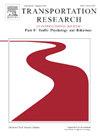小心缝隙!公共交通使用意愿预测因子的性别差异
IF 3.5
2区 工程技术
Q1 PSYCHOLOGY, APPLIED
Transportation Research Part F-Traffic Psychology and Behaviour
Pub Date : 2025-04-02
DOI:10.1016/j.trf.2025.03.013
引用次数: 0
摘要
作为可持续城市交通的基石,公共交通系统不断取得进展,为私家车使用、城市拥堵和污染提供了替代方案。在这种情况下,向定期使用公共交通的转变似乎受到几个因素的影响,先前的研究表明,安全问题、服务质量和环境价值是公共交通使用意愿的关键预测因素。然而,基于性别的旅行者意图和选择差异仍未得到充分研究。目的本研究旨在探讨公共交通使用意向的性别差异,重点关注个体因素、社会心理因素和交通系统相关因素作为结构性预测因素的作用。该研究使用了820名西班牙公共交通乘客的数据,按性别平均划分。通过电子调查收集的数据,使用多组结构方程模型(MGSEM)进行分析,以评估基于文献的预测因子与公共交通使用意图之间关系的性别差异。结果多变量分析显示,在公共交通系统特征感知和使用意愿方面,性别差异显著。尽管男女都对安全威胁表示高度关注,但女性在选择交通工具时更强调可持续性。此外,尽管外在激励不能显著预测使用意愿,但可持续性传播对男女都有影响,这表明有效的沟通可能有助于克服这种激励在促进公共交通使用意愿方面缺乏影响力的问题。除了这些因素对乘客水平的差异影响外,本研究的结果还突出了与公共交通的安全、服务质量、包容性和可持续性价值相关的具体关注点的性别敏感差异。政策意义这些结果支持了解决性别需求的必要性,这些需求可以提高公共交通系统的有效性,并支持更广泛的可持续交通目标。本文章由计算机程序翻译,如有差异,请以英文原文为准。
Mind the Gap! Gender differences in the predictors of public transport usage intention
Public transport systems continue to gain ground as a cornerstone of sustainable urban mobility, offering alternatives to private car use, city congestion, and pollution. In this context, the shift toward regular public transport use seems influenced by several factors, with previous studies suggesting that safety concerns, service quality, and environmental value are key predictors of public transport usage intention. However, gender-based differences in travelers’ intentions and choices remain underexplored.
Aim
This research aimed to investigate gender differences in public transport usage intentions, focusing on the role of individual, psychosocial, and transport system-related factors as structural predictors.
Methods
This study used data from 820 Spanish public transport travelers, evenly divided by gender. The data, collected through an electronic survey, were analyzed using Multi-Group Structural Equation Modeling (MGSEM) to assess gender-based differences in the relationships between literature-based predictors and public transport usage intentions.
Results
The multivariate analyses showed significant gender differences in the perception of public transport system features and usage intentions. While both genders reported high concerns regarding security threats, women placed greater emphasis on sustainability contributions in their transport choices. Moreover, although extrinsic incentives did not significantly predict usage intentions, sustainability dissemination did so for both genders, suggesting that effective communication may help overcome the lack of influence from such incentives in promoting public transport usage intentions.
Conclusion
The findings of this study highlight gender-sensitive differences regarding specific concerns related to safety, service quality, inclusiveness, and the sustainability value of public transport, beyond the differential influence of these factors on ridership levels.
Policy implications
These outcomes support the need to address gender-specific needs that could enhance the effectiveness of public transport systems and support broader sustainable mobility goals.
求助全文
通过发布文献求助,成功后即可免费获取论文全文。
去求助
来源期刊
CiteScore
7.60
自引率
14.60%
发文量
239
审稿时长
71 days
期刊介绍:
Transportation Research Part F: Traffic Psychology and Behaviour focuses on the behavioural and psychological aspects of traffic and transport. The aim of the journal is to enhance theory development, improve the quality of empirical studies and to stimulate the application of research findings in practice. TRF provides a focus and a means of communication for the considerable amount of research activities that are now being carried out in this field. The journal provides a forum for transportation researchers, psychologists, ergonomists, engineers and policy-makers with an interest in traffic and transport psychology.

 求助内容:
求助内容: 应助结果提醒方式:
应助结果提醒方式:


